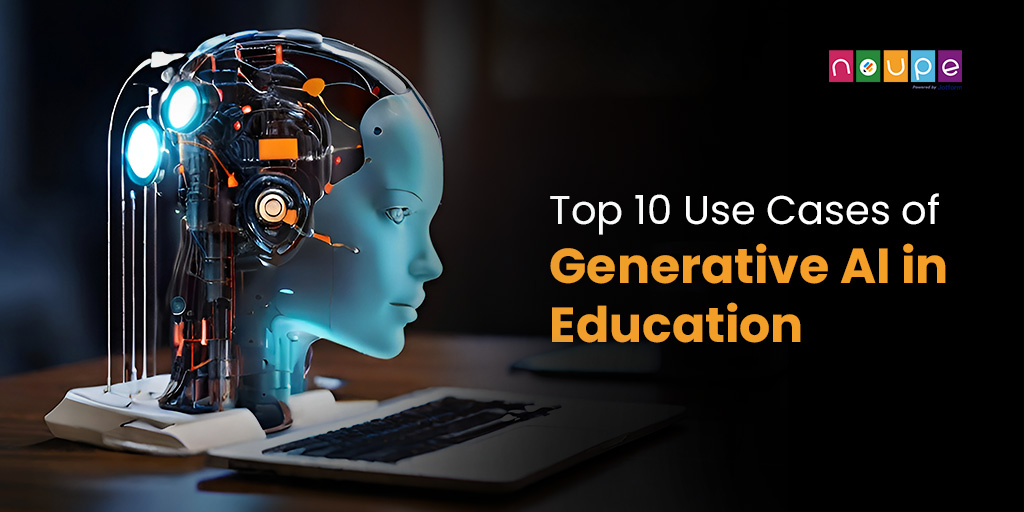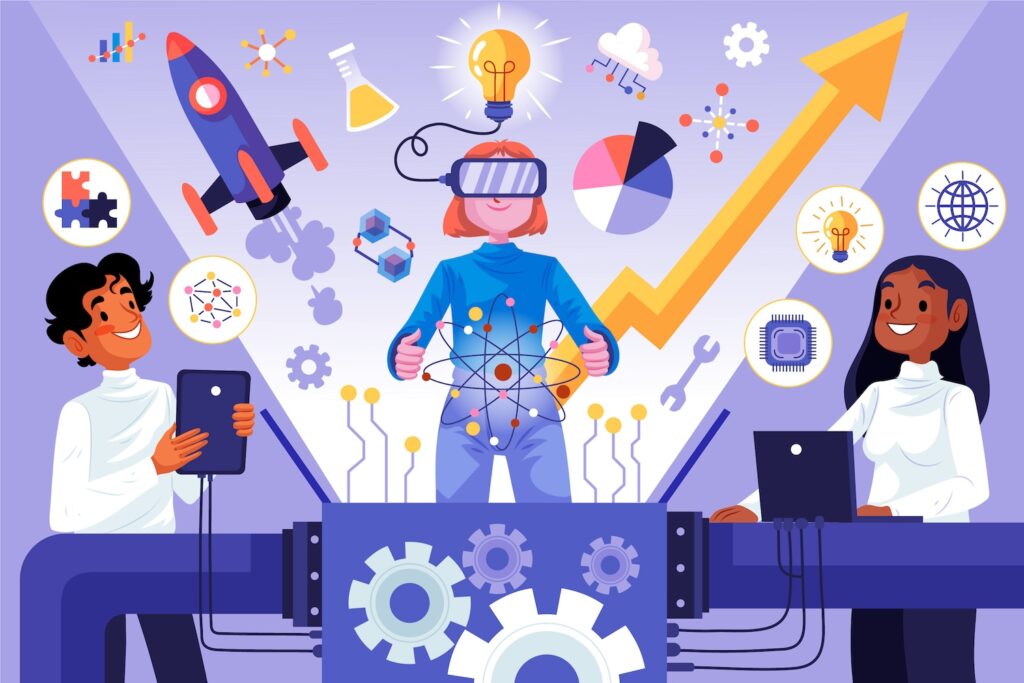
The world of education is changing faster than ever before, thanks to the continuously developing field of AI. Among the powerful subsets of AI, generative AI has started making its mark as a game-changer by transforming how teachers teach and students learn. This wide-ranging investigation therefore provides an in-depth understanding of using generative artificial intelligence in school settings; it does this by looking at what it can do, where it can be applied best in terms of personalizing learning experiences for different individuals or groups, automating some tasks which are time-consuming for educators and producing better quality content among others but also recognizes there being challenges and ethical considerations around its implementation too.
What Is Generative AI?
Looking at the past, traditional AI has been great at analyzing data it already knows, finding patterns, and predicting what will happen next. But then there’s generative AI—it moves in a completely different direction. Think about a place where artificial intelligence doesn’t analyze information alone but conceives fresh pieces of work as well. That’s what generative AI does. Contextualized language models that use deep learning algorithms can write text, translate languages, compose music, and create life-like images among others. Education has never had so many opportunities for lively learning!
Role of Generative Al in Education
Generative AI is a very complex tool in education. It does not only change how students learn but also affects how teachers teach. Here are some areas where generative AI has made a big impact:
• Personalized Learning:
One of the most interesting uses of generative AI is personalized learning. Just think about a classroom where every student gets taught according to his/her unique needs, preferences, and learning style. Generative AI takes advantage of student data, and performance as well as identifying their learning gaps thus creating individualized lesson plans for them while suggesting appropriate resources too giving this kind of feedback leads to better understanding which makes learning more enjoyable.
• Automating Tedious Tasks:
When it comes to record-keeping or grading assignments teachers find themselves spending too much time on them hence being overwhelmed by such tasks that are monotonous because they have been doing them over again. However, with generative AI these chores can be done quickly since this kind of technology works faster than humans do besides it does not get tired at all; therefore, if used well then educators could take up strategic initiatives like curriculum designing and providing support to learners one-on-one.
• Improving Content Development and Delivery Methods:
The use of books that have fixed content along with dull lectures should be discouraged now that we live in an age where everything changes at lightning speed thanks partly due to artificial intelligence which enables machines to think creatively just like human beings so as to generate other ideas too apart from what was inputted into them initially thereby making these devices even smarter than ever before especially when it comes down towards being knowledgeable about various subjects around us hence helping people become better-educated consumers unlike before when they were limited only within certain limits based upon irrelevant factors such as location or any other factor for that matter.
Use Cases of Generative AI in Education
AI in Education is currently experiencing a huge transformation caused by Generative AI. This type of technology, more powerful than traditional AI that only assesses available data, is designed to produce brand-new content. It presents various fascinating applications for learning such as personalized modules and automated grading among others. In this article, we are going to look at ten such uses in education
- Individualized Lessons: Just think about an educational system that adapts to the needs and preferences of every student it serves. Through analyzing students’ information, knowledge gaps as well as performance levels; generative AI can be used to create custom-made lesson plans so that no one feels left behind in school again.
- Course Designing: Static course outlines are now outdated since many factors need consideration while designing courses these days; this is where generative AI comes in handy too! With its ability to suggest topics based on national curriculums or state standards – teachers may find themselves having more time for other important aspects like teaching methods selection or even assessment types of identification.
- Content Creation for Courses: Many times, books fail because they lack the interactivity required during lectureships therefore through using generative AIs lecturers can come up with engaging materials that will enhance students’ comprehension further and still enable them to learn better by heart too. Imagine generating interactive quizzes from any topic under discussion which also touch different areas hence catering to all learners’ styles of understanding.
- Curriculum Planning: Preparing a curriculum can be quite tedious especially if done manually but when supported by generative AI it becomes easier since reports generated after utilizing learner’s records together trends could show what needs to change so that it aligns with educational objectives within a set period.
- Automated Grading and Assessment: After assessing several assignments, one tends to get bored hence employing generative becomes vital here as well because coming up with various tasks that will be checked automatically by a machine leaves teacher responsibilities more towards giving individual feedback based on these generated answers which might have been done wrongly or right so far.
- Task Automation: Many times, teachers are overwhelmed by the workload hence spending most parts of their day doing administrative works such as scheduling and record-keeping among others, but this could change if we introduce generative AIs into schools since they can automate such tasks thus freeing up teacher’s time for student engagement activities.
- Avatars in Different Languages: Learning foreign languages has always posed challenges particularly where there is very little cultural exchange taking place within classrooms however with the emergence of generative AI it becomes possible to create virtual characters capable of conversing various tongues. This would enable learners from different cultures to interact while at school thereby enhancing the language acquisition process even further still fostering an appreciation of diversity within educational settings.
- Revision And Practice Questions: Students need to be provided with revision materials and practice questions after completing a given topic or subject matter area therefore through using generative AIs they can now get customized ones depending on how well each performed during previous tests.
- Bridging The Timeline Gap: History comes alive when students can visualize the flow of time; this is what generative AI does best! By organizing current events alongside past happenings in an easily understandable manner – interactive timelines may help children connect dots between various historical incidents eventually leading them to realize why certain things happened as well as appreciate relevant highs and lows experienced throughout human civilization to date
- Generating Feedback: Besides assigning grades for work done by learners teachers are also supposed to provide adequate feedback about the same but unfortunately due to the limited time available many instructors opt to give only marks without indicating specific areas of strengths or weaknesses were observed instead pointing out merits and demerits made during preparation phase accordingly which could have enabled individuals to come up with suitable learning strategies aimed at overcoming such challenges in future
Challenges and Considerations: Navigating the Generative AI Landscape
Generative AI, though providing many advantages, has several challenges which must be recognized and dealt with:
- Concerns over Data Privacy: The proper collection, storage, and usage of student data is very important. Teachers and institutions need to have strong security measures for data in place as well as abide by privacy laws so that learners’ information remains confidential.
- Algorithmic Bias: Educational AI algorithms are capable of inheriting biases from the data they train on. This can result in unfairness or discrimination within education. Educators should know about possible prejudices and actively seek diverse representative training data. Moreover, it is necessary to introduce methods that reduce bias in algorithms thereby ensuring equity and fairness in artificial intelligence-based education systems.
- The Human Touch: A Balancing Act: Though generative AI has many benefits it must not replace the role played by human teachers who cannot be substituted. Empathy development, critical thinking skills growth, and social-emotional learning nurturing are fundamental elements of schooling that cannot be replicated by machines. The best approach therefore is one where teachers are empowered through generative AI while still maintaining their unique teaching practices.
How does Generative AI work in Education?
Integration of Artificial Intelligence into educational settings brings forth various ethical questions requiring continuous discussion. Here are some areas to focus on:
- Transparency and Explain ability: Educators as well as learners need to understand how generative AI works and why it produces certain results. This openness creates confidence amongst users which enables them to make informed decisions regarding its use within classrooms. To achieve this objective explainable AI techniques may be employed to enhance transparency during decision-making processes involving machines.
- Access and Equity: All schools regardless of their level should be able to afford generative AI solutions which means these systems need to be cost-effective. Digital equality issues must also be addressed since failure to do so will lock out some students from benefiting from such innovative learning tools based on their socio-economic backgrounds.
- The Potential for Misuse: Like any other powerful technology, generative AI can also be misused. For example, people might utilize AI-generated content for purposes of plagiarism or spreading fake news. Teachers, therefore, must stay watchful and come up with preventive measures. Critical thinking skills among students will have to be fostered to enable them to differentiate between reliable information and that produced by machines.
- The Road Ahead: AI can transform education through the personalization of learning experiences, automation of tasks, and enhancement in content creation thus making it more dynamic and engaging especially for those with diverse needs or learning styles. However, this calls for the responsible application of generative AI considering issues like data privacy, algorithmic bias, and ethics. As technology advances further within these fields teachers need not only shape its integration but also ensure learners’ safety which should remain our priority as we strive towards better education using such tools. Without a doubt, there is much still ahead of us if we want artificial intelligence to become truly transformative in schools.
FAQ (Frequently Asked Questions)
1. Is it possible for teachers to be replaced by generative AI?
Not! Generative AI is an addition to the teacher’s toolbox and not a substitute for them. It allows them to personalize lessons, automate tasks, and make content more interesting thereby enabling them to concentrate on student interaction and critical thinking skills development among others.
2. What are some of the ways that educators can guarantee the ethical use of generative AI in education?
Transparency and fairness should be prioritized. Educators need to select AI tools that reflect these values while having a clear understanding of how algorithms function within them. Also, they should be conscious of potential biases present in training data alongside nurturing critical thinking abilities among learners so as not to misuse artificial intelligence systems.
3. Does generative AI only apply when creating fancy visuals and text? What about other disciplines?
The capability of generative AIs goes beyond just images or words; think science simulations powered by AI models or even personalized maths problems for practice – this technology can adapt across different subject areas and learning preferences as well.
4. Aren’t generative AI tools costly? Can schools afford them?
The price tags attached to some generative AI applications have been known to be quite high, but this situation is rapidly changing with time as the availability increases too. Open-source alternatives are being made available which could benefit institutions through subscriptions or grants depending on their needs alongside affordability becoming more realistic going forward.
5. What are some concerns with using generative AI in education?
In terms of security, nothing is more important than Data privacy needs strict protective measures put in place especially where student information is stored. Moreover, there must also be a balance struck between accuracy within biased algorithms used by machines and ensuring that such technologies serve educational purposes rather than promoting plagiarism or spreading false news
Conclusion
Generative AI in education is a new era of limitless possibilities for personalized learning, content creation, and teacher empowerment. If we recognize the hurdles and address them carefully we can tap into this great potential that generative AI has in making education more interesting, and accessible to all learners with different abilities than ever before as well as exciting The road ahead needs collaboration, constant growth, and ethical commitment; Let’s embrace this tool which transforms everything because there are no boundaries on how much better we can make teaching or learning experiences look like while fun becomes its foundation.
The post Use Cases of Generative AI in Education appeared first on noupe.

